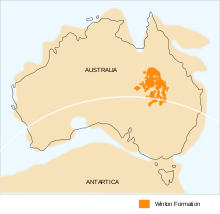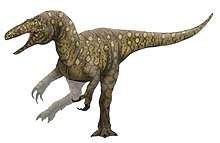Winton Formation
The Winton Formation is a Cretaceous formation in central-western Queensland, Australia. It is late Albian to early Turonian in age,[2] so straddles the Cenomanian-Turonian boundary.
| Winton Formation Stratigraphic range: Late Albian-Early Turonian ~104–92 Ma | |
|---|---|
| Type | Geological formation |
| Unit of | Rolling Downs Group |
| Underlies | Unconformity with Quaternary Lake Eyre Basin sediments |
| Overlies | Mackunda Formation,[1] Oodndatta Formation |
| Thickness | <100 m (330 ft) at the margin 1,200 m (3,900 ft) in the centre |
| Lithology | |
| Primary | Sandstone, siltstone, claystone |
| Other | Conglomerate, coal |
| Location | |
| Region | |
| Country | |
| Extent | Eromanga Basin |
| Type section | |
| Named for | Winton, Queensland |
| Named by | Whitehouse |
| Location | Bores in and around Winton |
| Year defined | 1955 |
 Formation distribution within Australia | |
The formation is a rock unit that blankets large areas of central-western Queensland. It consists of sedimentary rocks such as sandstone, siltstone and claystone. The sediments that make up these rocks represent the remnants of the river plains that filled the basin left by the Eromanga Sea - an inland sea that covered large parts of Queensland and central Australia at least four times during the Early Cretaceous. Great meandering rivers, forest pools and swamps, creeks, lakes and coastal estuaries all left behind different types of sediment.
In some areas, the Winton Formation is over 400 metres thick. To bring with them such a huge amount of sediment, the rivers that flowed across these plains must have been comparable in size to the present-day Amazon or Mississippi rivers. As more and more sediment was brought in, the margins of the inland sea slowly contracted. By around 95 million years ago, the deposition was complete and the inland sea would never be seen again.
By virtue of its age and the environmental conditions under which the rocks it consists of were deposited, the Winton Formation represents one of the richest sources of dinosaur fossils anywhere in Australia.
Fauna
A fossil footprint-(ichnite), Wintonopus, found with two other dinosaur genera footprints at the Lark Quarry in Australia, c.f. Tyrannosauropus and Skartopus, have been found in the Winton Formation.
Crocodyliformes
| Crocodyliformes of the Winton Formation | |||||
|---|---|---|---|---|---|
| Taxa | Species | Presence | Material | Notes | Images |
| Isisfordia | I. duncani | Nearly complete skeleton and partial skull, referred complete skull |  Isisfordia duncani | ||
Dinosaurs
| Dinosaurs of the Winton Formation | |||||
|---|---|---|---|---|---|
| Taxa | Species | Presence | Material | Notes | Images |
| A. wintonensis | Partial skeleton | A lightweight predatory megaraptoran theropod 6 meters (20 ft) long.[4][5][6] | |||
| Wintonotitan [3] | W. wattsi[3] | Partial skeleton | A giant herbivorous titanosaurian sauropod.[4] | ||
| D. matildae[3] | Partial skeleton | A giant, stocky herbivorous titanosaurian sauropod about 15–16 metres (49–52 ft) in length.[4] | |||
| A. mckillopi | |||||
| S. elliotorum[8] | Partial skeleton | A giant herbivorous titanosaurian sauropod about 15 metres (49 ft) in length.[9] | |||
| Wintonopus | Indeterminate | Tracks | |||
| Indeterminate | |||||
| Neornithischia | Indeteriminate | Tooth[10] | |||
| Indeterminate | |||||
| Indeterminate | Tracks | ||||
| Ankylosauria[11] | Indeterminate | 3 Isolated teeth from left and right dentary and right maxilla | |||
Pterosaurs
| Pterosaurs of the Winton Formation | |||||
|---|---|---|---|---|---|
| Taxa | Species | Presence | Material | Notes | Images |
| Ferrodraco[12] | F. lentoni | Anterior portion of a skull and dentary, anterior skull and dentary fragments, partial wing, cervical vertebral centra. | Anhanguerian | ||
See also
- Lark Quarry Conservation Park
- List of dinosaur-bearing rock formations
- South Polar region of the Cretaceous
References
- http://www.anra.gov.au/topics/water/availability/qld/gmu-winton-mackunda-formations.html
- Tucker, Ryan T.; Roberts, Eric M.; Hu, Yi; Kemp, Anthony I.S.; Salisbury, Steven W. (September 2013). "Detrital zircon age constraints for the Winton Formation, Queensland: Contextualizing Australia's Late Cretaceous dinosaur faunas". Gondwana Research. 24 (2): 767–779. doi:10.1016/j.gr.2012.12.009. ISSN 1342-937X.
- Hocknull, SA; White, MA; Tischler, TR; Cook, AG; Calleja, ND; et al. (2009). "New Mid-Cretaceous (Latest Albian) Dinosaurs from Winton, Queensland, Australia". PLoS ONE. 4 (7): e6190. doi:10.1371/journal.pone.0006190. PMC 2703565. PMID 19584929.
- "Scientists Find Dinosaur That Lived 98M Years Ago in Australia". Associated Press. Fox News. 3 July 2009. Retrieved 3 July 2009.
- "New dinosaurs found in Australia". BBC News. 3 July 2009. Retrieved 3 July 2009.
- "Triple Fossil Find Puts Australia Back On The Dinosaur Map". Science Daily. 3 July 2009. Retrieved 3 July 2009.
- Weishampel, David B; et al. (2004). "Dinosaur distribution (Late Cretaceous, Australasia)." In: Weishampel, David B.; Dodson, Peter; and Osmólska, Halszka (eds.): The Dinosauria, 2nd, Berkeley: University of California Press. Pp. 605-606. ISBN 0-520-24209-2.
- Poropat, S.F.; Mannion, P.D.; Upchurch, P.; Hocknull, S.A.; Kear, B.P.; Kundrát, M.; Tischler, T.R.; Sloan, T.; Sinapius, G.H.K.; Elliott, J.A.; Elliott, D.A. (2016). "New Australian sauropods shed light on Cretaceous dinosaur palaeobiogeography". Scientific Reports. 6: 34467. doi:10.1038/srep34467. PMC 5072287. PMID 27763598.
- Geggel, Laura (2016). "Wide-Hipped Dinosaur the Size of a Bus Once Trod Across Australia". Live Science. Purch.
- "Hypsilophodontid (Dinosauria:Ornithischia) from latest Albian, Winton Formation, central Queensland". Memoirs of the Queensland Museum. 52.
- Leahey, Lucy G.; Salisbury, Steven W. (June 2013). "First evidence of ankylosaurian dinosaurs (Ornithischia: Thyreophora) from the mid-Cretaceous (late Albian–Cenomanian) Winton Formation of Queensland, Australia". Alcheringa: An Australasian Journal of Palaeontology. 37 (2): 249–257. doi:10.1080/03115518.2013.743703. ISSN 0311-5518.
- Pentland, Adele H.; Poropat, Stephen F.; Tischler, Travis R.; Sloan, Trish; Elliott, Robert A.; Elliott, Harry A.; Elliott, Judy A.; Elliott, David A. (December 2019). "Ferrodraco lentoni gen. et sp. nov., a new ornithocheirid pterosaur from the Winton Formation (Cenomanian–lower Turonian) of Queensland, Australia". Scientific Reports. 9 (1): 13454. doi:10.1038/s41598-019-49789-4. ISSN 2045-2322. PMC 6776501. PMID 31582757.
